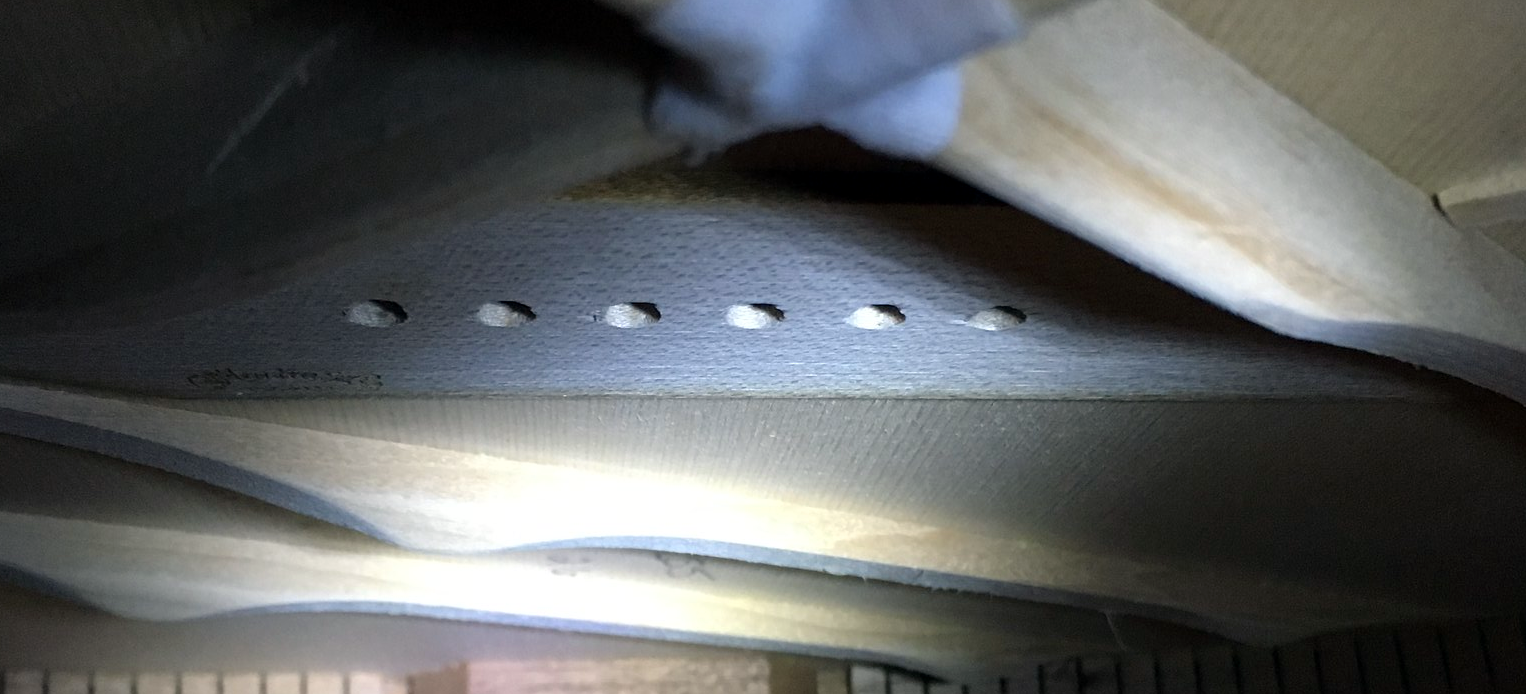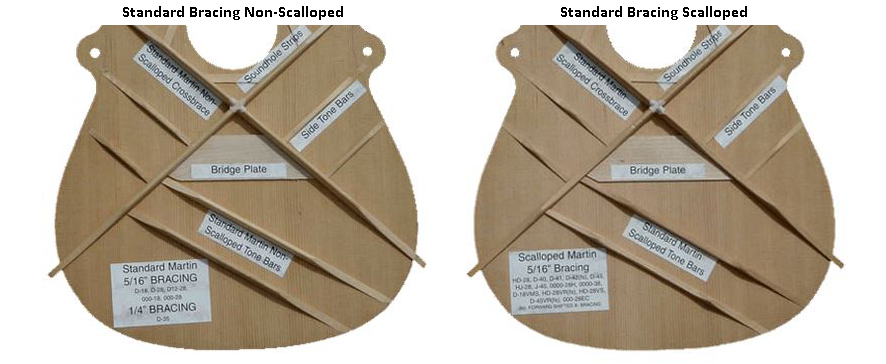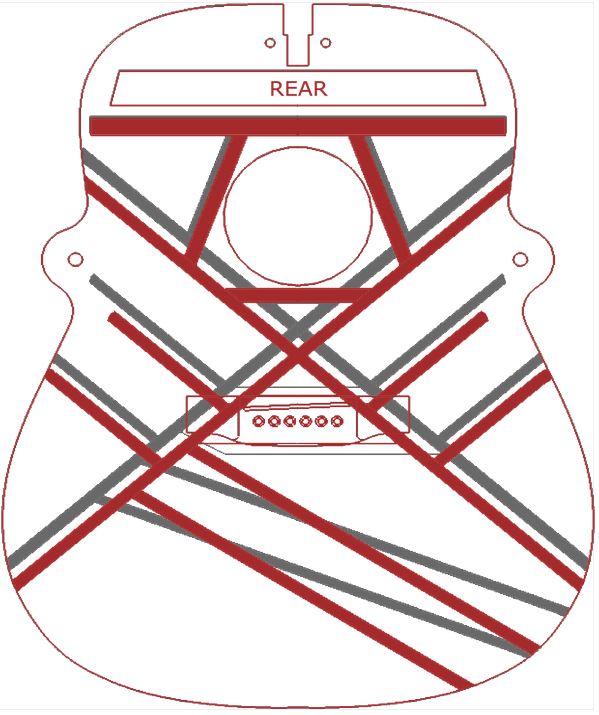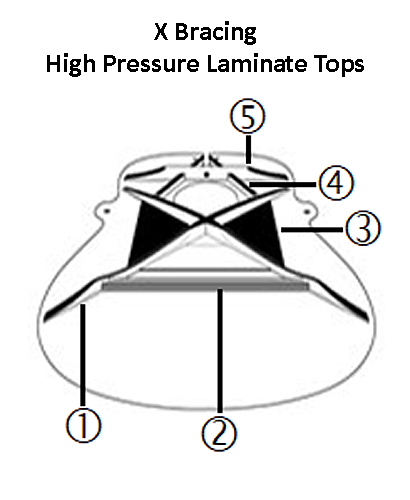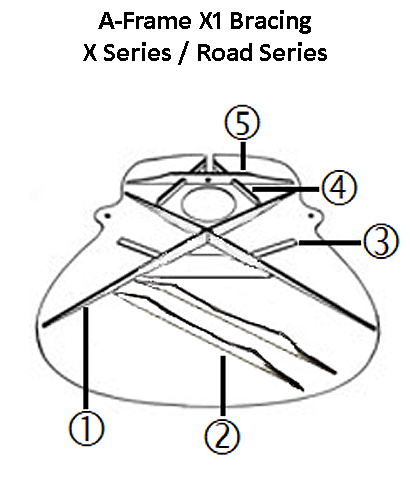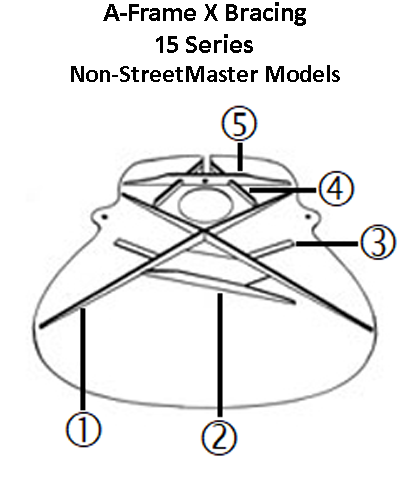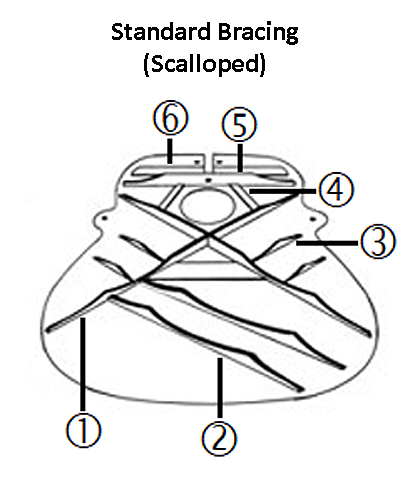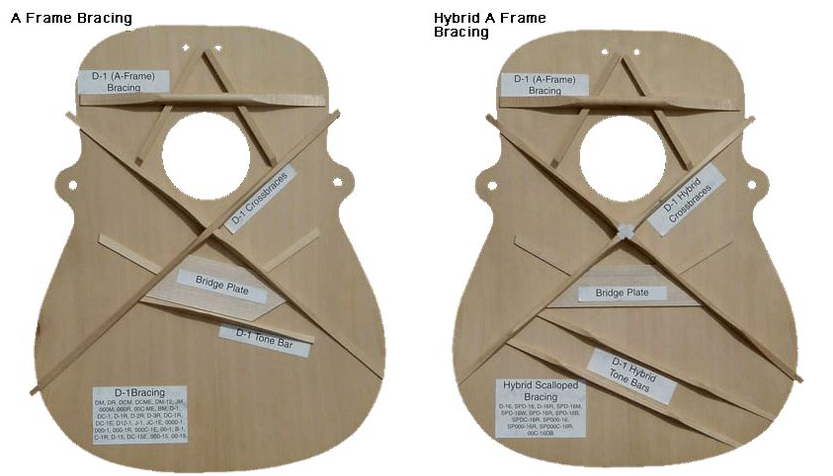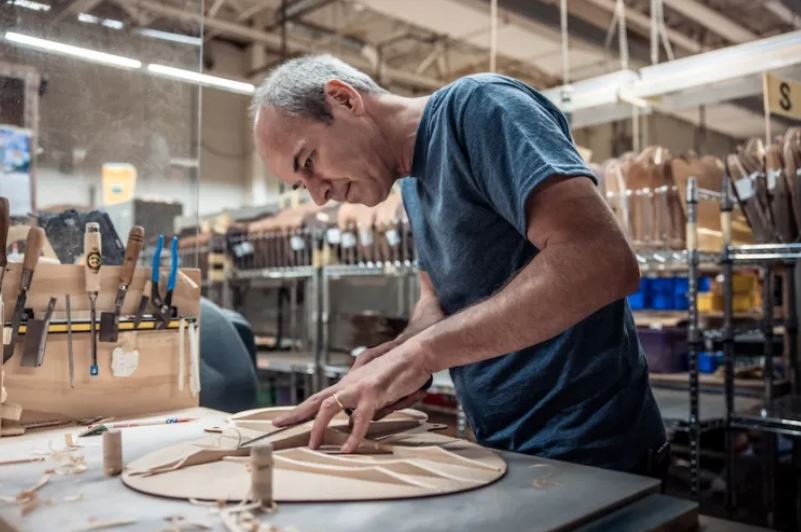Soundboard Bracing Patterns Currently in Use at C. F. Martin & Co.
The exclusive insider information inside your Martin that they don’t want you to know!
.
Standard Series Scalloped Bracing
REVISED: January 16, 2023
Important Notice
As of 2023, Martin is no longer listing Sitka spruce as the specification for soundboards for most models previously made with that species of spruce. The designation Martin will now be using simply says “spruce.”
This is because Martin will now be using Sitka spruce interchangeably with Lutz spruce, (a naturally-occurring hybrid of Sitka and White spruce,) in much the same way they use various species of mahogany interchangeably when making instruments in the 15 Series.
Lutz spruce grows in and in between the coastal regions of the Pacific Northwest where Sitka spruce is found and nearby interior regions where White spruce is found. It is supposed to provide greater volume than Sitka while sounding similar. Other people say it sounds like a cross between Sitka spruce and Engelmann spruce, which has also been used interchangeably with Sitka, most notably in the late 1900s on some Martin guitars like the HD-28.
Introduction
This guide contains information about the history of Martin guitar bracing and detailed descriptions of the types of bracing currently in use across the Martin line. This guide also corrects discrepancies existing in other sources due to out-of-date information, including certain spec sheets on the Martin website. The information in the tables below is based closely on recent discussions with the people at C. F. Martin & Co. who actually know what they are talking about.
Glossary of Terms
(If you already know all about Martin guitar bracing, feel free to scroll down to the tables below.)
Soundboard
The soundboard is the technical name for the top of a traditional acoustic guitar, because that is where the sound comes from. It is made of two very thin pieces of wood glued together at the center to make one continuous plane. When the strings are played, their kinetic energy is transferred to the soundboard, which begins to vibrate and put out sound waves. The back and sides of a guitar reflect and amplify the sound waves inside the sound chamber behind the soundboard.
When tuned to concert pitch, the strings pull on the soundboard with hundreds of pounds of tension, greatly increasing the potential energy in the soundboard, but also putting it under tremendous stress that threatens to warp the thin wood before tearing it off of the guitar. What prevents this from happening is the top’s bracing.
Bridge Plate
A thin plate is glued to the underside of the guitar’s soundboard to support the bridge attached to the top, called, sensibly enough, the bridge plate. It has holes drilled through it to accept the ball end of the strings and provide the area where they will anchor themselves when tuned to pitch, protecting the even thinner soundboard from being ravaged during years of the string ends digging into the wood. The bridge plate has some influence upon the tone producing energy passing from the strings to the top.
At Martin, all full-sized guitars have a bridge plate made of solid maple, except for instruments in the Modern Deluxe Series, which have a composite bridge plate made of a layer of torrefied solid Adirondack spruce between two thin plates of carbon fiber.
Bracing
The underside of the soundboard is supported by wooden struts, which at Martin are referred to as braces and bars, and collectively called bracing. They are laid out in a fashion that facilitates the transference of kinetic energy across the soundboard.
Bracing must be strong enough to withstand that tremendous stress from the strings, while at the same time being light and flexible enough to allow the top to vibrate as freely as possible to produce good tone. Finely crafted, professional-level guitars have a soundboard and bracing honed to the very envelope of their tolerances, so the musical instrument is as resonant as possible without falling to pieces when under the duress of vigorous playing. This is not an easy feat to achieve.
Bracing is usually made from Sitka spruce from the Pacific Northwest, prized for its ratio of strength to flexibility. Martins with soundboards made of stiffer eastern red spruce (aka Adirondack spruce) tend to be have bracing of that same wood. Guitars in the high-end Modern Deluxe Series have torrefied Adirondack spruce bracing under a torrefied Sitka spruce top.
In the early twentieth century, during Martin’s “Golden Era,” soundboards were made from Adirondack spruce and often braced with Sitka spruce. Claims that Martin always used Sitka bracing simply aren’t accurate. C. F. Martin III is on record saying his father cut down the spruce tree on their own lawn and used it for bracing. So at least one tree’s worth of eastern red spruce ended up bracing pre-war era soundboards.
X-Bracing
C. F. Martin Sr. invented what is known as X-bracing sometime around 1845, which revolutionized guitar making. It consists of a main X brace surrounded by various smaller braces called tone bars. Although the guitars of the day were quite small by modern standards and built to use gut strings similar to the nylon strings seen on modern classical and flamenco guitars, Martin’s X-bracing proved to be perfect for larger guitars. But X-bracing did not reach its true potential until the advent of steel string guitars, which Martin began to produce in the early twentieth century.
Scalloped Bracing
Around the same time Mr. Martin invented X-bracing he also developed a way to carve bracing that removes wood in elongated scoops, or “scallops,” to increase flexibility in a carefully controlled manner. This technique is known as scalloping the braces.
Scalloping creates sections of a brace or tone bar that are quite shallow, so the strut has greater flexibility, allowing the soundboard to vibrate more freely in that area so it is responsive to lighter playing with enhanced resonance. It also creates peaks between the scallops that maintain stability while acting as damping nodes on specific tonal frequencies, in a manner similar to how a graphic equalizer sculpts the sound of a home stereo system.
When it comes to vintage Martins, the guitars made after the Second World War onward have non-scalloped bracing, (aka straight bracing.) There are various claims as to why Martin abandoned scalloped bracing after C. F. Martin III took over the day to day management of the company in the mid-1940s. The popularity of heavy gauge strings is one common supposition. But the true reason seems to be found in the economics of faster production to meet the growing demand for the products of a small company offering handmade musical instruments, while also reducing the number of warranty repairs.
Bracing of the type used at Martin in the pre-war era was a time consuming process requiring highly-skilled labor shaping each brace by hand with a chisel. By the time Martin opened their new factory in 1961 they were years behind in filling dealer orders, even after 15 years of cutting out the step of scalloping braces.
Scalloped braces returned in a limited way in the 1970s. By the 1990s the public’s desire for guitars made more like pre-war Martins brought about various vintage reissue models made with scalloped bracing, while more and more standard models were also converted to scalloped braces. In this century, some form of scalloped bracing is found on most Martin guitars.
Today, only the higher-end Martins have their braces scalloped by hand after the bracing has been glued to the soundboard. Any scalloping done on Martins in the X Series, Road Series, 15 Series, 16 Series, and 17 Series are shaped by machines prior to installation.
Guitars without scalloped braces are known for their strong fundamental notes with precisely defined tonal parameters to the bass, mid-range, and treble registers. Today, Martins with non-scalloped braces include the Standard Series’ D-28 and D-35. The scallop-braced versions, the HD-28 and HD-35, have more body resonance swelling out around those fundamental notes, with a complex blending of the registers, increased sonic reverberation, and a warmer bottom end.
NOTE: The following illustration was provided to Martin sales reps to explain to dealers how scalloped bracing differs from non-scalloped. It is many years old, so the information about what models have which bracing is entirely out of date. It likewise does not represent the forward-shifted bracing in use today.
Non-Scalloped Bracing vs. Scalloped Bracing
Forward Shifted Bracing
Forward-shifted bracing refers to the specific location of the center of the main X brace between the sound hole and the bridge plate. That position also dictates the position of the surrounding tone bars.
When the 14-fret Dreadnought size was introduced in 1934 the main X brace was placed one inch from the sound hole. This is now known as forward-shifted bracing, because in 1938 they moved the X brace position to 1-3/4″ from the sound hole, a placement now referred to as rear-shifted bracing.
Rear-Shifted vs. Forward-Shifted Bracing
While people speak of these bracing patterns in relation to the sound hole, it is really all about the distance from the bridge plate. Forward-shifted bracing provides less support to the area around the bridge plate, while also affecting the responsiveness of the large lower bout, e.g. the area of the top below guitar’s waist. The result is enhanced flexibility in those areas for increased responsiveness, resulting in a throatier voice with greater bass response than guitars made with an X brace closer to the bridge plate.
Sometime around 1960 the position of the X brace was moved forward to 1-1/2″ from the sound hole. For some 40 years, this was referred to as “standard bracing,” “non-forward-shifted bracing,” or the “modern position.”
As with scalloped braces, the increasing popularity of pre-war Martins led to the return of forward-shifted braces. At first, this showed up in a limited edition sort of way, leading to the introduction of the Vintage Series in the 1990s, followed by the Golden Era Series and Marquis Series, and eventually the Authentic Series. These different series offered increasing vintage Martin details, at different price points. The specifics of how the bracing is shaped also changed across the series, but they all had forward-shifted bracing on the large Dreadnought body size.
Today, the bracing used on the Vintage Series instruments has been absorbed into the Standard Series and applied to newer body sizes introduced in the modern era. The brace-shaping of the Golden Era and Marquis Series is found on the Modern Deluxe Series. Only the Authentic Series has ever offered bracing positions and shaping truly identical to Martins made in the 1930s.
Forward-Shifted Bracing vs. Non-Forward-Shifted Bracing
In 2018, the “reimagined” Standard Series was converted to forward-shifted bracing on all models made in larger body sizes (Grand Performance, Dreadnought, 0000 (aka M,) Jumbo, Grand Jumbo.) So, today, Standard Bracing is forward-shifted bracing by default.
In the illustrations above, provided by Martin Guitars, you can see how it is not just a matter of the bracing being shifted forward. The angle of the tone bars across the lower bout and the distance between them is significantly different in the forward-shifted pattern when compared to both the rear-shifted bracing of the 1940s and ’50s and the later non-forward-shifted pattern used on standard models until 2018.
The only model currently in production with rear-shifted bracing is the D-18 Authentic 1939 (and the Aged version of that model.) No models are being made with the pre-2018 “standard bracing.”
Martin Bracing Patterns in Use Today
Note: The following illustrations approximate actual Martin bracing patterns and are not technical drawings.
Martin Guitars Made in Navojoa, Mexico
Martin Guitars Made in Nazareth, PA
Standard Bracing
Standard Bracing is the direct descendant of the original X-bracing invented by C. F. Martin Sr. and perfected for steel-string guitars in the early twentieth century by his decedents. It is named for the Standard Series, which encompasses the modern versions of iconic models that existed before the 1990s, made in Styles 18 through 45, which all retain the traditional, full-size, hand-fitted dovetail neck joint. (See my guide Understanding Martin Model Designations for detailed descriptions of current Martin series and styles.)
Brace Radius
The braces and tone bars used in Standard Bracing are made with a built-in radius. This means a strut does not lie flat when you set it on a tabletop, but has a slight arc to it, with a radius of about 46″ – e.g. if the piece of wood continued onward with the same bend it would create a circle 46 inches in diameter.
When glued down flat onto the soundboard, the strut is in a constant state of tension as it pulls against the top in a effort to spring back into its original shape. This additional tension from all the various braces and bars increases the potential energy being stored in the soundboard, in anticipation of the kinetic energy coming from the played strings that will put everything into motion. In effect, the subtle radius of traditional Martin bracing supercharges a top and is one of those little-known but very important facets that contribute to the phenomenal tone of a classic Martin guitar.
Until recently, this was only found on guitars made in the Standard Series and others made with the traditional, full-size dovetail neck joint and solid American mahogany neck block. Thanks to the modern innovations that have allowed Martin to create machine-shaped bracing, Standard Bracing is now also used on most models in other instrument series constructed with the modern Simple Dovetail neck joint, designed for less-expensive Martins. It is a greatly improved generation of the old Mortise and Tenon neck joint that does not require the extra A-Frame braces and neck block bolt used to stabilize the earlier design. Today’s Simple Dovetail neck joint also features a solid neck block of the African mahogany species called sipo, rather than the plywood block used for the M&T neck joint instruments made in Navojoa, Mexico.
Retired Bracing Patterns
Here is an example of the Hybrid A-Frame bracing pattern (right) used on higher-end guitars that employed the Mortise and Tenon neck joint, beginning in the mid-1990s and continuing until the Simple Dovetail neck joint replaced the M&T neck joint a few years ago. This included all 16 Series and 17 Series instruments, guitars among the upper tiers of the Performing Artist Series, as well as certain limited edition Martins like the MTV-1, and artist signature models that were mainly aimed at younger guitarists and took advantage of the cost savings that comes with the M&T neck joint.
This pattern combined features of Standard Bracing with the A-Frame X bracing (left) still in use on 15 Series instruments, and here included for comparison’s sake. As mentioned above, Martin is considering retiring A-Frame X bracing in the future and putting the new machined Standard Bracing on all 15 Series guitars. But with the disruption of production due to the COVID-19 pandemic, this change may still be a years away from the present day.
All Martin guitars made with the M&T neck joint since the 1990s have one of these two bracing patterns. The chief differences between Hybrid A-Frame bracing and the A-Frame X1 bracing used today in the Road Series and X Series is the X brace. The X1 uses the X brace seen on the left and, as stated above, the tone bars below the X brace are machine-shaped and do not have the exact same look as the ones pictured above in the right-side photo.
Special Thanks
Tim Teel, Director of Instrument Design, Rameen Shayegan, Manager of International Instrument Design, and Michael Dickinson of Wood Procurement and other considerable expertise; each an incredibly valuable asset to the continued success of C. F. Martin & Co., which I hope will become clearly apparent to the new CEO Thomas Ripsam, seen here scalloping braces at the Martin factory.
If you have found this article of use to you, please consider buying me a cup of coffee, or a set of guitar strings, by donating to oneman@onemanz.com. The COVID-19 pandemic upheaval has taken a heavy toll on my ability to meet basic living expenses like rent, healthcare, and guitar strings.
